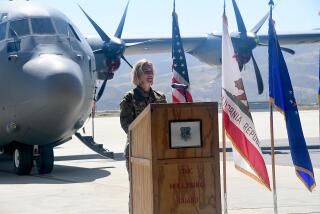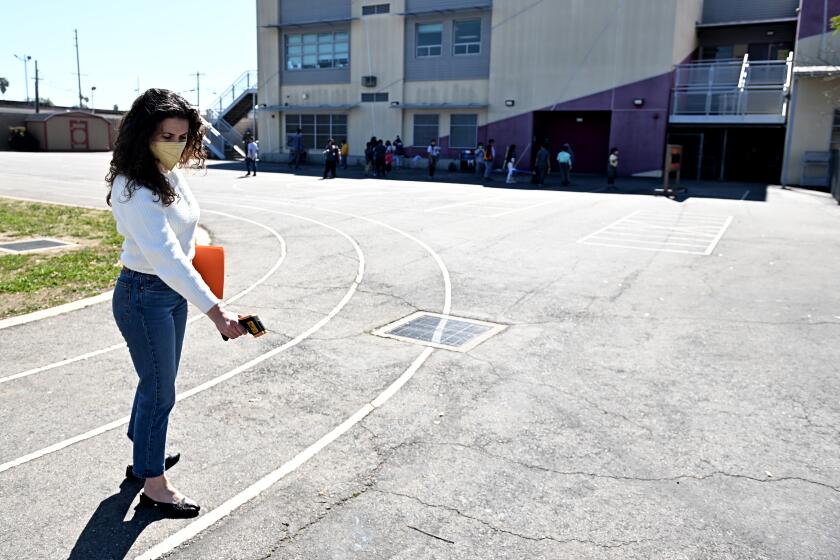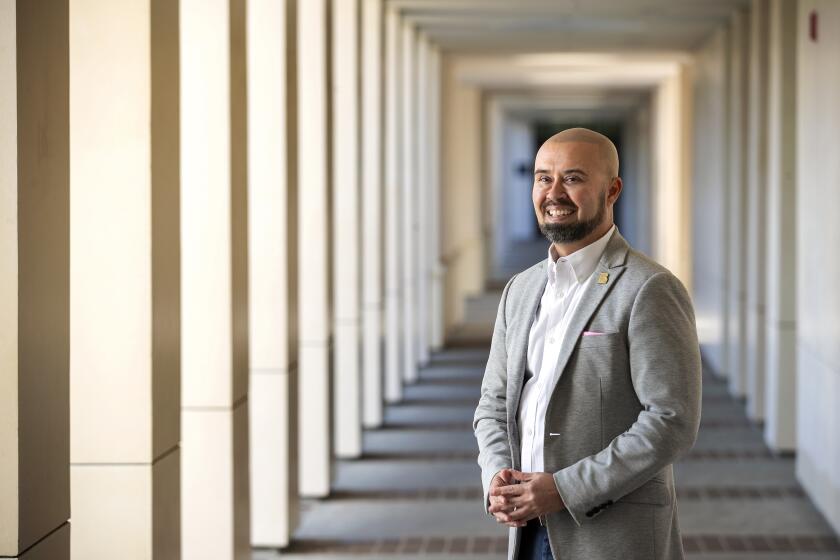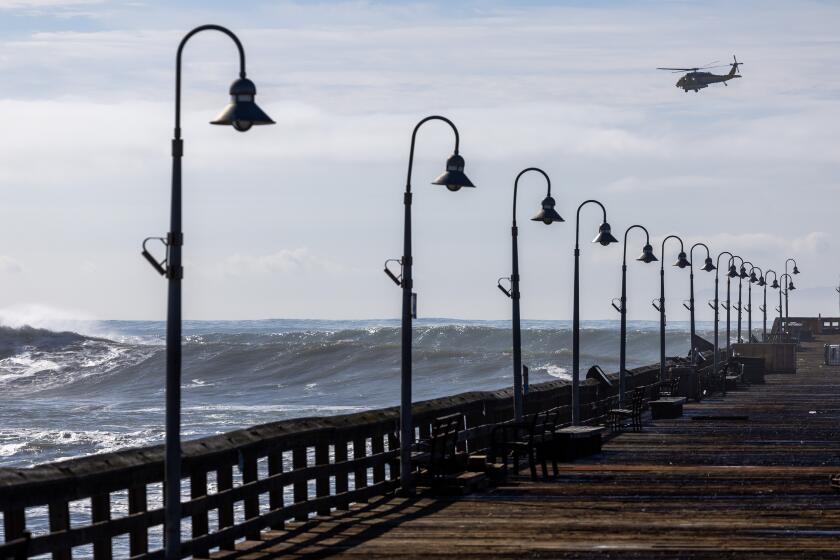L.A.’S NEW LIBRARY : How Books Helped Build Los Angeles : Thriving Despite Two 1986 Fires and Many Earlier Travails, The Central Library Offers a Hopeful Vision of Los Angeles
Cities and libraries came into history together. Each represents an extension of human experience through time. Each is based on community, shared values, memory of the past, hope for the future.
Great cities, such as Los Angeles has managed to become (sometimes in spite of itself!), require equally great public library systems. In fact, no city that neglects its library can claim greatness. Like transportation, schools, police and fire protection, library service is not a luxury. It is basic to the urban formula.
In modern times, the relationship between a flourishing library and information system, accessible to the general public, and the well-being of a democratically run city, is no mere piety. Democracies require an informed citizenry. People must be informed to remain autonomous, hence free.
Knowledge is wealth and power. Knowledge is also economic survival, especially in times of economic scarcity. And when a recession, like the current one, is coinciding with an era in which jobs are being transformed in their structure and content from year to year, access to information--to new knowledge, to re-tooling, to retrofitting for jobs that didn’t exist five years ago--becomes a necessity.
Los Angeles has many problems. We see them in the news and experience them on the street. But the story of the Los Angeles Public Library offers genuine cause for optimism. Whether we look at the new immigrant learning about our our common culture by visiting one of the library’s 63 branches, or at the dynamic and eccentric librarians who have made the overall system arguably the finest in the nation, the LAPL offers proof positive that things can work in Los Angeles; that Los Angeles has a past, present and future worth fighting for; that Los Angeles--as all great cities must be--is not just part of the problem, but part of the solution.
*
Long before Los Angeles had colleges or universities or an art museum, or a water system, or a deep-water port, even before it had a direct railroad connection to the east, Los Angeles had a library. As early as 1844, when the city was still a Mexican pueblo, a group of citizens calling themselves Los Amigos del Pais , the Friends of the Country, secured a small lot from the ayuntamiento , or town council, and built a library-recreation hall on North Main Street near what is now Olvera Street. Like the architects of the period, whose Monterey Colonial style uniquely blended the New England frame house with the Mexican adobe, these early librarians helped establish a distinct cultural identity for California.
When Los Angeles was transferred to the jurisdiction of the United States in 1846, Anglos opened a Mechanic’s Institute Library, a corrugated iron building on Spring Street where blue-collar immigrants could teach themselves skills in demand. While the institute only lasted two years, a library association opened a reading room in 1859 with the help of Henry Mellus, a bookish Bostonian who in 1835 had sailed around the Horn with Richard Henry Dana Jr., author of “Two Years Before the Mast” (1840). The next year Mellus was elected mayor of Los Angeles, proving once again that politicians who are good to libraries get ahead.
In 1872, 200 leading Los Angeles citizens, concerned that the absence of a truly public library was being “spoken of to our injury abroad,” formed the Los Angeles Library Assn. The association’s board included the elegant, aristocratic Mexican judge Ygnacio Sepulveda, the shrewd land dealer and merchant John Downey (who later became California’s seventh governor), and Harris Newmark, whose vivid, gossipy memoir “Sixty Years in Southern California” (1916) was described by journalist Charles Lummis as the “Samuel Pepys Diary of Los Angeles.” With Anglo, Latino, Catholic, Protestant and Jewish trustees, the board represented a rather dramatic diversity for its time and place and signaled the present and impending diversity of Los Angeles.
In 1878, the Los Angeles Public Library passed completely from the control of the Library Assn. and became a department of city government, with the mayor selecting what was now called the Board of Regents. At long last, Los Angeles had a truly public public library.
The first city librarian--the erudite and lanky journalist John Littlefield--put off some readers by smoking abominably smelling stramonium leaves to ward off his asthma attacks. Nevertheless, he managed to secure larger quarters for the library near a fashionable French bistro and to open a Ladies’ Reading Room wherein women could avoid uncouth males as well as those “impure, vicious . . . blood and murder class” novels.
Despite such attitudes, it was a series of remarkably assertive and independent-minded women, serving as city librarians of Los Angeles from 1880 to 1905, who truly put the Los Angeles Public Library on the map. At a time when government careers were largely prohibited to women, who were not able even to vote in California until 1911, librarianship offered a unique career field in which they could display their executive abilities. Nowhere was this more true than in Los Angeles.
The redoubtable Tessa Kelso, for instance, city librarian from 1889 to 1895, had read omnivorously as a youngster in the Cincinnati Public Library before becoming a journalist. She smoked cigarettes--sometimes in public!--and had a head for business as well as for books. In her six years as librarian, she increased the collection sevenfold. There were 132 library cards issued when she took over. There were 20,000 when she left.
Her accomplishments were impressive--from developing the music and California history collections to outlining the need for a distinguished Central Library building downtown--but her attitude was extraordinary for her time. “For years woman has worked, talked and accepted all sorts of compromises to prove her fitness to hold the position of librarian and to demonstrate that sex has no weight where ability is equal,” she fumed in one letter to the American Library Assn. “There is but one standard of management for a live business, and sex has nothing to do with that standard.”
Tessa Kelso left Los Angeles in 1895 to join the publishing house of Charles Scribners Sons in New York. Her successor, Clara Fowler, was unschooled in literature but sharp at accounting: She pointed out that Los Angeles was circulating about half as many books as New York on only one third of the income. Next came Harriet Child Wadleigh, who tackled a burning question in libraries at the time: Should books be openly accessible to the public. If the gross and vulgar hordes could peruse volumes at will, argued opponents of “open shelving,” libraries would suffer loss, theft, disorderliness and all the kindred ills. Wadleigh argued otherwise; obtaining the permission of her board to convert the library to open-shelving, she made Los Angeles among the first to test this innovation and prompted a considerable upsurge in library use.
Wadleigh’s successor, Mary Jones, City Librarian from 1900 to 1905, brought a new dimension, impeccable academic credentials, along with administrative expertise to her role. If Tessa Kelso was outspoken, Bohemian and occasionally outrageous (she once launched a libel suit against a minister who criticized her for allowing a racy French novel to remain on the shelf), Mary Jones was stately, dignified, academic--and equally effective.
In her regime, the training program that Kelso had established in 1891 became a formally organized library school. Among other things, Jones integrated the Los Angeles Public Library into the Library of Congress card catalogue system. Branches were established in Vernon, the Arroyo Seco district, Pico Heights, and Hollywood. An African-American librarian was assigned to the Arroyo Seco branch, then in the center of a heavily African-American district, and encouraged to develop a collection relating to what was then called the Negro experience in America.
By the time Mary Jones left office in 1905, the rise of the library during her and her successors’ regimes dovetailed with the rise of Los Angeles itself. Between 1890 and 1900, the population of Los Angeles had grown from 50,395 to 102,479. In the next 20 years it would grow to 576,673. And by 1930, to 1,238,048.
A great new metropolis was being formed on the west coast of the United States: a horizontal, eclectic, dynamic, sometimes eccentric city, teeming with an elderly but surviving pioneer generation of Anglo-Americans and German Jews; a later generation of folks and babbitts from the Midwest; Irish and Jews from New York; Chinese from Northern California (direct immigration from China had been cut off in the 1880s); Japanese from Japan; a small but ambitious African-American community (it produced Nobel Laureate Ralph Bunche and, later, Tom Bradley); Latinos who were either descendants of the first European settlers or recent migrants from Mexico; together with the usual mix of most American cities in the Age of Immigration, then at its zenith.
Fortunately, three librarians, each of them distinguished in a very different way, were on hand to lead the LAPL into its modern period between 1905 and 1947. When Charles Fletcher Lummis became city librarian in 1905, Los Angeles was entering an era of sustained growth. When city librarian Althea Warren resigned in 1947, Los Angeles and its library had pushed themselves into the front rank of American cities and American library systems.
A classmate of Theodore Roosevelt’s at Harvard, an expert on the history and literature of the Spanish Southwest and the former city editor of The Times, Charles Fletcher Lummis, who served from 1905 to 1910, saw the library as a cutting edge institution that could help the city and its surrounding hinterlands find a place in the sun that would be more than a matter of climate. A desert health faddist, Lummis was also an impresario who sold Southern California to the nation by promoting a romanticized and idyllic vision of its missionary past.
Critics have taken Lummis to task for some of his unorthodox practices at the library, from using a hot cattle-brand to mark expensive reference books “Property of the Los Angeles Public Library” to locking the library into an expensive lease which proved near-ruinous. Yet whatever his faults--the poseur element of his green corduroy charro suits and ever-present cigars, his haphazardness as an administrator, the concurrent distractions of his literary and journalistic career, the terminal egotism that got him into trouble with directors and elected officials--Lummis gave to the Los Angeles Public Library, especially its Special Collections, Western history and California above all else, an institutional distinction that it would never lose.
Charles Fletcher Lummis believed in Everyman and Everywoman as Reader, as a person embarked upon a voyage of self-improvement and self-discovery that only books and reading could serve. At the library, Lummis established a Department of Reading, Study, and Research to assist individual citizens, no matter where they might stand on the social and economic scale, in their reading needs, appointing as its director Dr. C.J.K. Jones, “the walking encyclopedia.” As library historian John D. Bruckman recalls, Jones would amble the “halls and reading rooms, pouncing on any hapless patron who may have been wearing a puzzled air, to give him the benefit of the information stored in his voluminous mind.”
Lummis’ de facto successor, Everett Robbins Perry, patiently and skillfully pursued his dream of building a great Central Library downtown. In 1914 Perry moved the library to the four upper floors of the Metropolitan Office Building at Fifth and Broadway, vowing that the next time the Library relocated, it would be into its own building. With Perry’s urging, the city in 1921 passed a $2.5 million bond issue for a new central library building and branches. In 1922 the City deeded to the library board the present site of the Central Library on Normal Hill.
In the first half of the 1920s, Los Angeles was in the process of becoming the Great Gatsby of American cities: a self-envisioned, self-actualized metropolis, dividing and sub-dividing itself with awesome rapidity, absorbing a million people, laying plans to tap the waters of the mighty Colorado, nurturing the film and aeronautical industries, making its port the fourth busiest in the nation. It was a boosting, boosting time; and the library bond issue campaign played on this boosterism. How could Los Angeles, pro-bond issue advertisements queried, allow its Library to rent space above a drug store? “Mr. Average Taxpayer,” ran the ad, “pay fifty cents a year and remove this stigma from Los Angeles’ name!”
Remove that blemish, Los Angeles did. Los Angeles created, in fact, a Central Library, dedicated in 1926, which today, 67 years later, remains a primary icon--like City Hall or the Biltmore Hotel or Watts Tower--of Los Angeles identity. At once historical in reference and minimalist avant-garde, lavish yet touched by a certain austerity and restraint, the Central Library, designed by Bertram Grosvenor Goodhue with the assistance of Carleton Monroe Winslow, said and continues to say something very powerful about the social and imaginative context of a great city hastily assembled in a few short decades.
Significantly enough, the people of Los Angeles, operating through the Library Board and the Art Commission, helped make the building better. Goodhue’s first suggestion for the library, complete with tiled dome, struck the Library Board and art commission as the kind of accepted solution a flashy New York architect might dash off on behalf of a provincial city. The Library Board and the Art Commission demanded something more avant-garde, something touched with the modernism, the sense of an unfolding future, that Los Angeles saw as being so essential to its basic formula, along with its Spanish and Mexican heritage.
To Goodhue’s credit, he responded to this challenge--albeit after some huffiness--and produced for Los Angeles a masterpiece of 1920s modernism that also reflected the Spanish and Mexican past.
To behold, then to enter the Central Library at the time of its dedication in June 1926 was to experience the single most profound statement that Los Angeles had ever made about itself in any of the arts. From this perspective, three years before the opening of City Hall, the Central Library revealed to the rest of the nation the inner landscape of Los Angeles as an imagined city--as a city that had constructed its identity out of selected, eclectic people and materials--and gestured in the direction of a bright and promising future.
Like Los Angeles itself, the Central Library bespoke the passion for something better, something more than the ordinary, the dream of a better life that had brought Everyman and Everywoman to Los Angeles in the first place. Here in architecture, statuary, gardens, fountains, and, above all else, books, books, books, could be glimpsed the imagined Los Angeles, the city of dreams, the place where America, in dialogue with all cultures of present and past, could flourish.
During the Depression, Perry’s successor, Althea Warren, saw the democratic importance of a public library corroborated and put sorely to the test. Its budget slashed, the library nevertheless opened its doors each morning to long lines of readers, many of them out of work, looking for an hour or two of release from the terror of unemployment. Then came the war and by the early 1950s the beginnings of the longest economic boom in the history of the nation, which saw Los Angeles double its population.
And still, in the midst of it all--the hard-boiled L.A. noir of Raymond Chandler, the disillusioned emigre Los Angeles of Thomas Mann, the underworld L.A. of Bugsy Siegal and Mickey Cohen, the sinister Los Angeles of the Black Dahlia murder, the first smog crisis, the housing shortage and the subsequent creation of overnight neighborhoods--the citizens of Los Angeles continued to read. The year 1957, the year of Sputnik, saw more than 10 million books circulate.
“A very striking fact I have noticed,” Aldous Huxley wrote Althea Warren during this period, “is that even the most serious books in the library are in constant demand; for the date cards on the fly-leaf show that many of them get taken out 10 or a dozen times a year.”
Warren’s successor in 1947, Harold Hamill, found his solid reputation for marshaling financial support challenged during his 23-year administration. The postwar reading boom--symbolized by the lines of people that would snake from bookmobiles when they began visiting neighborhoods in the ‘50s--suggested the need for a new cluster of community branches, each anchored by one super-regional branch. Hamill got the job done by promoting a $6.4 million bond issue, which was passed by voters in 1957. The timing was prescient, for only a few months later the Russians’ successful orbiting of Sputnik triggered a nationwide scramble for educational achievement.
Where Hamill focused on regional service, his successor in 1969, Wyman Jones, was necessarily preoccupied with the Central Library. With no air conditioning, few fans, and poor ventilation, librarians and users were forced to endure suffocatingly hot summers and cold, drafty winters. The collection was as poorly housed as the librarians and patrons. The multilevel stacks were airless, inaccessible, and dark: illumination was provided by an occasional 40-watt bulb and staff working in dim corners carried flashlights.
*
When Proposition 13 slashed property taxes in 1978, Jones found himself with scant public funding to improve the central building. Arguing that only a plan that would pay for itself could sell itself, Jones began searching for the kind of public/private partnership deal that has lead to the recently completed renovation.
The arsonist or arsonists who attacked the Central Library on April 29, 1986, and again on September 3, damaged but could not destroy the mysterious alchemy between Los Angeles and its library. Indeed, like the 1984 Olympics, the battle to save the books from fire and water damage united the city as rarely before. More than 1,700 Los Angelenos volunteered to help 1,000 library staffers load 1.3 million books into boxes, 700,000 of them for immediate shipment to cold storage facilities.
In fact, the library fires catalyzed a movement to rehabilitate the library that had been stalled since 1966, when the Green Report pointed out the inadequacies of the 40-year old building and more than half-hinted that it be disposed of in favor of a new facility. The threat of such an abandonment delayed creative action for 20 years, as preservationists fought every attempt to abandon the central facility. As early as May, 1967, Los Angeles voters turned down a $54 million library bond issue precisely because they feared the money would be used to demolish the Central Library.
The solution eventually selected--the transferring of Central Library air rights to a neighboring site in exchange for substantial payments toward a $213.9 million renovation, rehabilitation and expansion of the existing landmark--bespeaks the kind of public/private cooperation, to the advantage of each, that must characterize public works in American cities in the decades to come.
*
And now, the Central Library, under the direction of city librarian Elizabeth Martinez, makes its stunning second debut. As a dream, as a hope, it is as old as Los Angeles itself, and as new and unexpected. A city that can solve such a problem--an antiquated yet deeply meaningful building, a two-time arsonist’s attack, a shortage in public funds, a recession--surely can solve other problems as well.
Walking through their new facility in 1926, the citizens of Los Angeles had clear evidence that their city had come of age.
What will their successors experience in walking through these same, albeit augmented spaces, when they reopen this Sunday? A sense of contrast between the beauty of the building and the often unbeautiful realities of the city? Or perhaps a surge of confidence, hope even, that Los Angeles having done this, having saved and transformed this exquisite building, might do other things on behalf of itself as well: teach, learn, heal, reconcile--lead to the vision of a better city, encourage in people a better sense of who they are and what their future can be, which is the ever-enduring goal of the public library.
More to Read
Start your day right
Sign up for Essential California for news, features and recommendations from the L.A. Times and beyond in your inbox six days a week.
You may occasionally receive promotional content from the Los Angeles Times.






